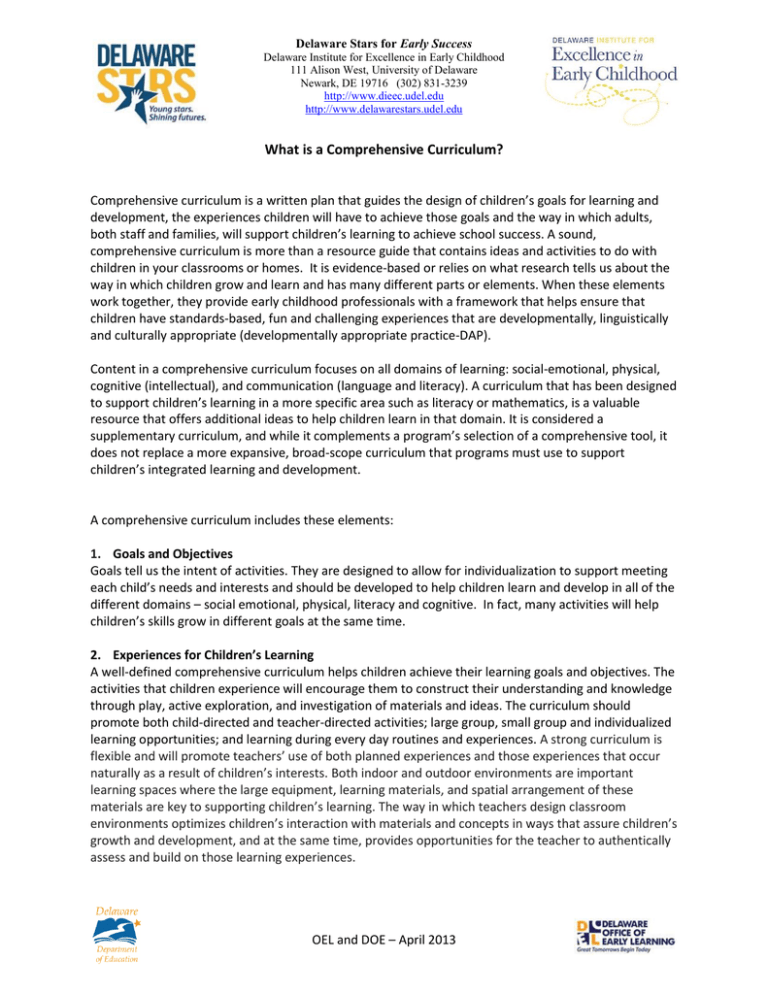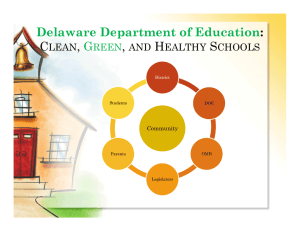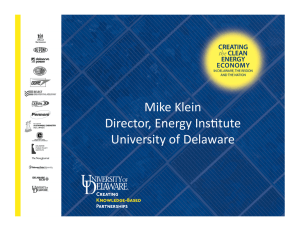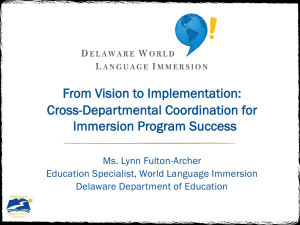What is a Comprehensive Curriculum?
advertisement

Delaware Stars for Early Success Delaware Institute for Excellence in Early Childhood 111 Alison West, University of Delaware Newark, DE 19716 (302) 831-3239 http://www.dieec.udel.edu http://www.delawarestars.udel.edu What is a Comprehensive Curriculum? Comprehensive curriculum is a written plan that guides the design of children’s goals for learning and development, the experiences children will have to achieve those goals and the way in which adults, both staff and families, will support children’s learning to achieve school success. A sound, comprehensive curriculum is more than a resource guide that contains ideas and activities to do with children in your classrooms or homes. It is evidence-based or relies on what research tells us about the way in which children grow and learn and has many different parts or elements. When these elements work together, they provide early childhood professionals with a framework that helps ensure that children have standards-based, fun and challenging experiences that are developmentally, linguistically and culturally appropriate (developmentally appropriate practice-DAP). Content in a comprehensive curriculum focuses on all domains of learning: social-emotional, physical, cognitive (intellectual), and communication (language and literacy). A curriculum that has been designed to support children’s learning in a more specific area such as literacy or mathematics, is a valuable resource that offers additional ideas to help children learn in that domain. It is considered a supplementary curriculum, and while it complements a program’s selection of a comprehensive tool, it does not replace a more expansive, broad-scope curriculum that programs must use to support children’s integrated learning and development. A comprehensive curriculum includes these elements: 1. Goals and Objectives Goals tell us the intent of activities. They are designed to allow for individualization to support meeting each child’s needs and interests and should be developed to help children learn and develop in all of the different domains – social emotional, physical, literacy and cognitive. In fact, many activities will help children’s skills grow in different goals at the same time. 2. Experiences for Children’s Learning A well-defined comprehensive curriculum helps children achieve their learning goals and objectives. The activities that children experience will encourage them to construct their understanding and knowledge through play, active exploration, and investigation of materials and ideas. The curriculum should promote both child-directed and teacher-directed activities; large group, small group and individualized learning opportunities; and learning during every day routines and experiences. A strong curriculum is flexible and will promote teachers’ use of both planned experiences and those experiences that occur naturally as a result of children’s interests. Both indoor and outdoor environments are important learning spaces where the large equipment, learning materials, and spatial arrangement of these materials are key to supporting children’s learning. The way in which teachers design classroom environments optimizes children’s interaction with materials and concepts in ways that assure children’s growth and development, and at the same time, provides opportunities for the teacher to authentically assess and build on those learning experiences. OEL and DOE – April 2013 3. Varied Domains of Learning A rich curriculum will assure that children have opportunities to expand their learning and development in all domains or areas of learning. This is known as “the whole child.” These areas include social and emotional learning, physical development, language and literacy skills, and the cognitive areas of knowledge that address mathematics, science, social studies and creative expression. Experiences that are included within the curriculum framework should be integrated or demonstrate how they can incorporate varied domains within one activity. Technology is also a new, but important, area of learning that should be included within a curriculum model. 4. Connection to Learning Standards Delaware’s Early Learning Foundations for Infants and Toddlers and Preschoolers are based on the ageappropriate expectations for children that explain what children should know and do at specific ages. When a curriculum is aligned or cross-walked with the Early Learning Foundations, it assures that children are receiving experiences that are based on age-appropriate standards across all of the domains of learning and that the expectations for learning are challenging, yet realistic and attainable. A comprehensive curriculum will also correspond to classroom or teacher assessments such as the Environment Rating Scale or CLASS to assure classrooms plan for high quality performance that is demonstrated in their scores. 5. Plans for Teachers A curriculum should include ways that teachers can help children achieve or reach their goals and objectives. Delaware’s Educational Enduring Understandings state that teachers must understand how children learn and design learning environments that complement children’s learning needs. The curriculum should guide teachers’ thinking about their own intentional role and include ways in which they can purposefully provide materials, ask questions or design the environment to help children learn through play and investigation. Delaware’s teachers use essential questions to stimulate children’s thinking and help them transfer current knowledge to new situations (scaffolding). 6. Ways to Measure Children’s Learning Curriculum must include an ongoing process for understanding each child’s growth and development and progress towards meeting their learning goals. This process provides the evidence that children are learning and should include strategies for observing and documenting children’s current levels of development, their interests and their needs as well as analyzing that information to develop new or modify learning objectives. 7. Diversity and Inclusivity Activities that are linked to children’s personal experiences are more meaningful and often provide more successful ways for them to learn. The curriculum should provide information on ways to provide experiences that reflect the cultures and backgrounds of the children within the early learning site. The curriculum should also be appropriate or provide for adaptations for children with varied abilities including children that are English Language Learners or children with disabilities. 8. Family Engagement Families and teachers work in partnership to help children achieve learning success. The curriculum should include ways in which families share in children’s individualized goal-development, provide information about their progress, or participate in classroom experiences. It should include ways to assure family celebrations or events include consideration of family cultures and ethnic practices and provide ways to make adaptations for those cultural or ethnic practices or for adults who may have OEL and DOE – April 2013 2 special needs. Suggestions for at-home connections will enrich the families’ understanding and supports for children’s experiences and learning and should be provided throughout the curriculum model. Resources: Delaware Department of Education. Curriculum Resources: Essential Questions, Essential Understanding and Design Principles. Retrieved from http://www.doe.k12.de.us/info National Association for the Education of Young Children and the National Association of Early Childhood Specialists in State Departments of Education. (2003) Joint Position Statement. Early Childhood Curriculum, Assessment, and Program Evaluation. Building an effective, accountable system in programs for children birth through age 8. Retrieved from http://naeyc.org/positionstatements/cape North Carolina Division of Child Development & Early Education. North Carolina Approved Early Childhood Curricula. (2011). Retrieved from http://nccchildcare.dhhs,state.nc.us Taylor, H.H., (2000). Curriculum in Head Start. Head Start Bulletin. Issue 67. Retrieved from http://eclkc.ohs.act.hhs.gov OEL and DOE – April 2013 3 OEL and DOE – April 2013 4 Delaware Stars for Early Success Delaware Institute for Excellence in Early Childhood 111 Alison West, University of Delaware Newark, DE 19716 (302) 831-3239 http://www.dieec.udel.edu http://www.delawarestars.udel.edu Comprehensive Curriculum Rubric Use this rubric to review the curriculum you intend to use in your early childhood program. A comprehensive curriculum includes all of the elements and indicators described below. Evidence of shaded elements is required for approval. Evidence of additional elements is strongly recommended. Curriculum Element Indicator Goals and Objectives Individualization Allows for individualization to reflect children’s needs and interests; built on children’s prior knowledge Age-Specific Experiences and themes are appropriate for the age and developmental range of skills children may demonstrate Schedules Experiences for Learning Environment and Materials Flexibility Transitions OEL and DOE – April 2013 Description Yes/No Evidence Includes a balance of individual, small and large group; active and quiet; indoor and outdoor and teacher and childdirected activities; utilizes active learning and exploration; utilizes routines and everyday learning opportunities Room designs, physical space (both indoor and outdoor), and learning centers utilize materials from all domains of learning; encourages children’s independent access to materials; offers suggestions for adaptations to support varied types of learning for all children Allows for teachable moments or changes to schedule, planned activities or events to accommodate children’s interests or needs or a unique event; offers ways materials or activities can be adapted to accommodate children’s individualized learning needs Presents strategies and ideas for moving children between experiences or activities as well as ways to introduce new ideas or experiences 5 Curriculum Element Indicator Reflects the Whole Child Varied Domains of Learning Integrated Experiences Technology Connection to Standards Aligned to Delaware Early Learning Foundations Research-based Purposeful or Intentional Plans for Teachers Sample Lesson Plans Professional Development OEL and DOE – April 2013 Description Yes/No Evidence Includes all domains of learning –social and emotional, physical, cognitive and language-literacy Offers ways children can learn varied skills or information from one activity (integration) Includes ways that technology can be incorporated into classroom or home experiences as well as ways teachers can use technology to record children’s progress and learning All domains of either infant-toddler or preschool Early Learning Foundations are addressed including: Infant-Toddler: Social-Emotional, Language and Literacy, Discoveries, Physical Development and Health Preschool: Social-Emotional; Approaches to Learning; Language and Literacy; Mathematics; Science; My Family, My Community, My World; Creative Expression; Physical Development and Health Reflects current information about ways children learn and develop (evidence-based); cites brain-research; evidence exists that curriculum is effective when implemented with fidelity; developmentally, culturally and linguistically relevant Guides teachers’ design of schedules and experiences that focus on children’s goals; emphasizes the use of questioning techniques to help children learn; uses scaffolding or ways to build on prior knowledge; Offers sample lesson plans or strategies for building lesson plans that incorporate children’s goals and integrate domains of learning Provides suggestions for related professional development or offers resources to understand the way in which the curriculum is written and should be used 6 Curriculum Element Indicator Relates to Delaware Department of Education Curriculum materials Link to Performance Measures Families Measures Children’s Learning (Assessment) Observation and Documentation Reflects Classroom Observation Tools’ requirements Adaptations Diversity and Inclusivity Culture Goal-Planning Includes a Family Component OEL and DOE – April 2013 Link to At-home Learning Description Yes/No Evidence Helps teachers see link to Essential Questions and Enduring Understandings http://www.doe.k12.de.us/infosuites/staff/ci/default.shtml Aligns with performance measures that allow adults to understand children’s growth and skill mastery of the presented skills through authentic assessment strategies Provides suggestions for sharing information about children’s progress with families Includes ways children’s growth can be measured through ongoing observation and related documentation of specific activities Considers measured items on classroom or teacher assessment scales to support quality scores and the coordination of varied assessments Provides suggestions for ways experiences can be adapted or modified to accommodate children with unique learning needs Encourages consideration for children and families’ culture, ethnicity and other unique community and family characteristics as experiences and activities are developed Provides ideas to include families in goal-planning, family educational activities and information-sharing Experiences include extension ideas that link children’s early care and education learning with at-home ideas 7




